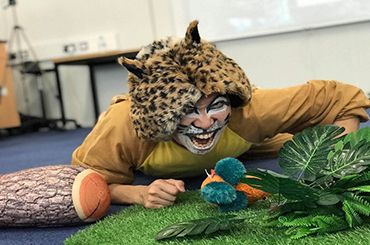Playing serious games
Cedric Tan and colleagues are using ‘serious games’ to explore conservation issues with public audiences, encouraging them to make choices that will help protect the environment.
Tan and colleagues have built on this research to develop games that help people explore conservation issues and understand how their own actions may impact on tropical forests and their inhabitants – even at a distance.
A biologist by background, Tan started to develop games as learning tools to use with his university students. “About eight years ago, I made a conservation ‘snakes and ladders’ out of bits of cardboard” he explains. “It helped the students revise their knowledge and they really enjoyed this way of learning!”
Tan then realised the potential to use games to engage public audiences. Working with colleagues, he has now developed a number of serious conservation games (games with an educational as well as a recreational purpose) and shared them with audiences at science fairs and open events in the UK and Malaysia.
An interactive theatre game allows the audience to make choices between two options which can lead to different outcomes. The decision to ban or allow wood harvesting for instance will have different consequences. “But there is no simple good or bad choice,” says Tan. “Sustainable wood harvesting from old trees, that allows them to regenerate and supports local incomes, may be a good option. The games help people to consider all aspects of an environmental problem, and have a deeper understanding of the complexities involved.”
The WILDCRU game allows participants to explore different scenarios such as selecting a chocolate brand that is better or less good for the environment, and encounters with an oil palm farmer, a trophy hunter or an eco-tourist. Interestingly, those exposed to the trophy hunter (who kill big game for recreation) were less opposed to the activity than those who were not as they were able to understand the benefits of carefully controlled hunting, including financial incentives offered to conserve habitats.
Part of the Escape Room game involves a supermarket scenario in which participants are able to buy goods that have a lesser or greater impact on the environment. Participants learn how choices they make, such as buying products made with palm oil (a major driver of deforestation), can directly contribute to forest clearance. Feedback from participants showed that the game influenced their attitudes and intended behavior: many asked about alternatives to palm oil products and said they planned to choose these in future.
“We think this is an innovative way of engaging public audiences with conservation issues,” comments Tan. “The games really help participants understand these complex issues, and how their choices can impact the environment. There are serious games to support learning in business and medical science, but there are very few based on academic research in conservation.”
“But the engagement is not one way,” he continues. “We really benefit from listening to external audiences. It helps us to understand public perception of controversial conservation issues, how to make our research relatable to everyday life, and how best to deliver our messages. This has actually led to a new stream of academic research investigating the effects of serious games on conservation teaching and we’re writing up these findings to share with others.”
Dr Tan would like to acknowledge the help of the following collaborators in developing the conservation games: Amy Hong, Jennifer Spencer, and Ran Peleg.
Dr Cedric Kai Wei Tan is a lecturer at Oxford Brookes. He was a post-doctoral researcher in the Wildlife Conservation Research Unit (WILDCRU) within the Department of Zoology and a lecturer of Wadham College.
Funders: Knowledge Exchange Seed Fund, University of Oxford, Public Engagement with Research Seed Fund, University of Oxford, National Geographic Society, British Ecological Society, Wildlife Conservation Research Unit (WildCRU).
